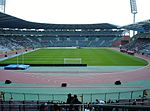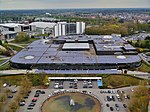Heysel Plateau

The Heysel Plateau (French: Plateau du Heysel, Dutch: Heizelplateau) or Heysel Park (French: Parc du Heysel, Dutch: Heizelpark), usually shortened to Heysel (French: [ɛzɛl]) or Heizel (Dutch: [ˈɦɛizəl] (listen)), is a neighbourhood, park and exhibition space in Laeken, northern Brussels, Belgium, where the Brussels International Exposition of 1935 and the 1958 Brussels World's Fair (Expo 58) took place. The Atomium, a symbolic 103-metre-tall (338 ft) modernist structure, originally built for Expo 58, is the most impressive monument on the Heysel Plateau and is now considered a landmark of Brussels. Opposite it, the Centenary Palace is one of the lasting remaining buildings of the 1935 World's Fair. It was also the venue for the 32nd Eurovision Song Contest in 1987. Currently, it is home to the Brussels Exhibition Centre (Brussels Expo), the city's most important event complex in Belgium and the largest exhibition space in the Benelux.The Heysel Plateau was also the location of the Heysel Stadium, Belgium's former national stadium, originally built in 1930. After the Heysel Stadium disaster of 1985, which claimed the lives of 39 spectators at the European Cup final, it was demolished and in its place was built the more modern and secure King Baudouin Stadium. The Bruparck entertainment park (with among others Mini-Europe miniature park and Kinepolis cinema) and the Planetarium of the Royal Observatory of Belgium are also located there, as is the Palais 12/Paleis 12, a large and modern multiuse indoor arena with a maximum capacity of 15,000 people. This site is served by Heysel/Heizel metro station on line 6 of the Brussels Metro.
Excerpt from the Wikipedia article Heysel Plateau (License: CC BY-SA 3.0, Authors, Images).Heysel Plateau
Place de Belgique - Belgiëplein, Brussels
Geographical coordinates (GPS) Address Nearby Places Show on map
Geographical coordinates (GPS)
| Latitude | Longitude |
|---|---|
| N 50.9 ° | E 4.3369444444444 ° |
Address
Palais 5 - Paleis 5
Place de Belgique - Belgiëplein
1020 Brussels
Belgium
Open on Google Maps








